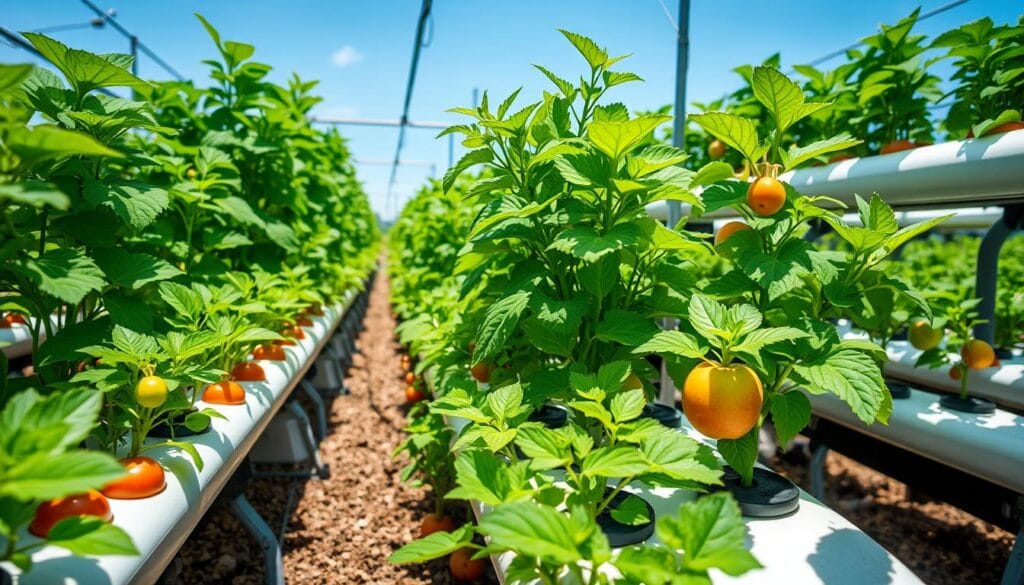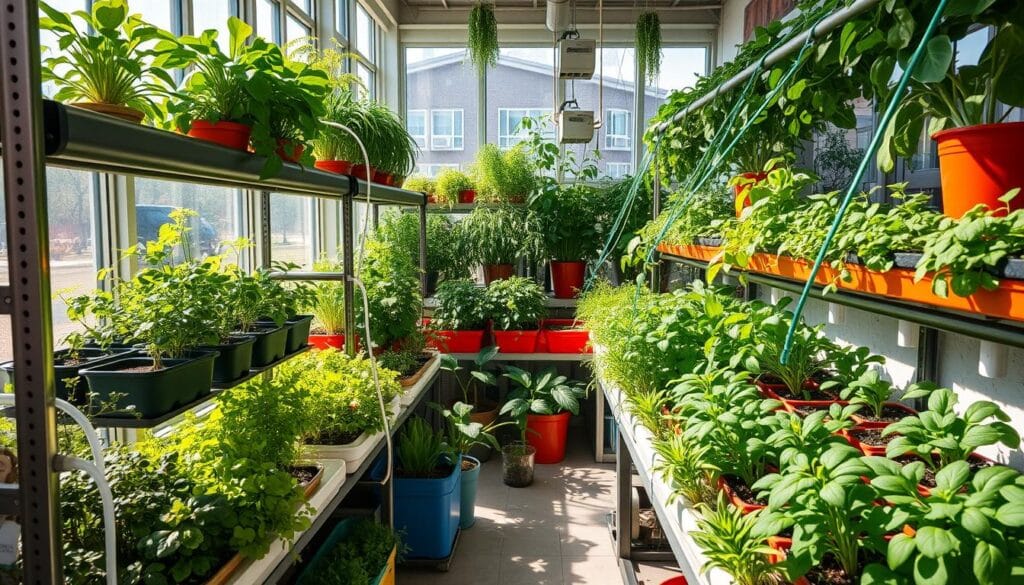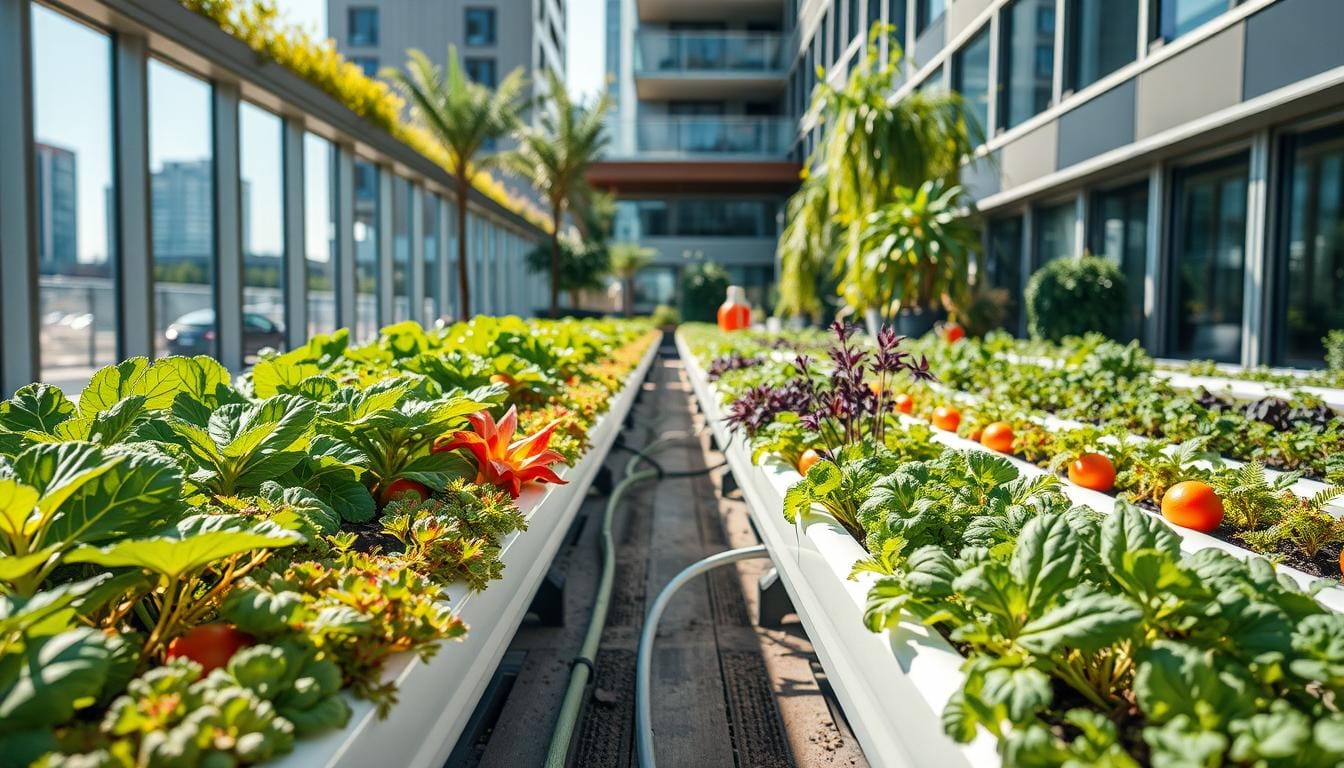I’ve always loved gardening, but soilless gardening changed everything. It lets you grow plants without traditional soil. This idea was both exciting and full of promise.
In this article, we’ll look at seven amazing benefits of soilless gardening. These include better nutrient control and water efficiency. They can solve many gardening problems and open up new possibilities for everyone.
Key Takeaways
- Soilless gardening offers superior control over nutrient delivery and pH levels for optimal plant growth.
- Soilless mixes are free from soil-borne pests, diseases, and weed seeds, reducing the need for pesticides and herbicides.
- Hydroponic and soilless systems are highly efficient in water usage, promoting sustainability.
- Soilless gardening provides space-efficient solutions for urban farming and vertical greenhouses.
- Soilless mixes, such as coir and perlite, offer excellent moisture retention and aeration for healthy plant development.
Understanding Soilless Gardening: A Modern Approach to Plant Cultivation
Soilless gardening, also known as hydroponics, is a new way to grow plants. It doesn’t use soil like traditional gardening. Instead, it uses nutrient-rich solutions and other mediums to help plants grow.
At the core of soilless gardening is giving nutrients directly to the roots. This makes plants absorb nutrients better and grow faster.
The Science Behind Hydroponic Systems
Hydroponic systems give plants the nutrients, water, and oxygen they need to grow well. They don’t need soil because they use mediums like perlite or coconut coir. This enhances plants’ ability to absorb nutrients and water more efficiently.
These systems let growers control things like pH, temperature, and light. This helps plants grow in the best conditions.
Different Types of Soilless Growing Methods
- Hydroponics: A method where plants are grown in nutrient-rich water solutions, without the use of soil.
- Aeroponics: A technique where plant roots are suspended in the air and misted with a nutrient-rich solution.
- Aquaponics: A sustainable system that combines aquaculture (fish farming) with hydroponics, creating a symbiotic ecosystem.
Soilless gardening has many benefits. It saves water, is better for the environment, and lets us grow crops all year. As we look for more sustainable gardening, soilless gardening is changing how we grow plants and food.
Accelerated Plant Growth and Enhanced Yields
Soilless gardening is a game-changer for growing plants fast and getting more crops. It’s different from using soil because it lets plants focus on growing above ground. This makes plants grow up to 30% quicker, as they use more energy for leaves, stems, and fruits.
Soilless systems also make it easier for plants to absorb nutrients. With a special nutrient solution, plants get what they need quickly. This leads to bigger and more crops, especially for leafy greens and herbs that love hydroponic setups.
| Soilless Gardening Advantages | Conventional Soil Gardening |
|---|---|
|
|
Soilless gardening helps growers get the most out of their plants. It leads to faster plant growth, increased crop yields, and better nutrient absorption efficiency. This modern way of growing food opens up new chances for sustainable and high-yielding farming.
“Soilless gardening has revolutionized the way we grow our food. The ability to precisely control nutrients and environmental conditions has unlocked unprecedented levels of productivity and efficiency.”
Complete Control Over Nutrient Delivery
Soilless gardening lets you control nutrient delivery precisely. You can tailor nutrient solutions to your plants’ needs. This ensures your plants get the best nourishment at every stage of their life.
Balanced Nutrient Solutions
In a soilless system, you can provide a balanced nutrient solution. This includes all the necessary macronutrients and micronutrients. This control helps prevent deficiencies and promotes healthy plant growth.
pH Management and Water Quality
Keeping the right pH and water quality is key for your soilless garden. Monitoring and adjusting pH levels helps your plants absorb nutrients well. Also, optimizing water quality creates a perfect growing environment for your plants.
Customizing Nutrients for Different Growth Stages
Soilless gardening lets you adjust nutrients as your plants grow. By changing the pH control and nutrient ratios, you meet your plants’ needs at every stage. This ensures they grow well from seedling to mature plant.
| Nutrient | Function | Deficiency Symptoms |
|---|---|---|
| Nitrogen (N) | Promotes vegetative growth, leaf development, and chlorophyll production. | Stunted growth, yellowing of older leaves, reduced biomass. |
| Phosphorus (P) | Supports root development, flowering, and fruit production. | Delayed maturity, purple discoloration of leaves, reduced yields. |
| Potassium (K) | Enhances drought tolerance, disease resistance, and overall plant vigor. | Curled, wilted, or discolored leaves, reduced root growth. |
Soilless gardening’s precision helps manage nutrient solution management, pH control, and water quality optimization. This ensures your plants thrive and reach their full potential.
Elimination of Soil-Borne Diseases and Pests
Soilless gardening gets rid of soil-borne diseases and pests. Without soil, problems like root rot and nematodes are greatly reduced. This makes growing plants healthier and reduces the need for harmful chemicals.
In traditional gardening, soil can harm plants. It can cause stunted growth and lower yields. But, soilless systems keep plants safe from these issues. This lets gardeners focus on making their plants healthy and strong.
| Benefit | Explanation |
|---|---|
| Reduced disease pressure | Soilless systems eliminate the risk of soil-borne diseases, such as root rot, fusarium wilt, and pythium, which can devastate traditional soil-grown plants. |
| Decreased pest infestations | Without soil, pests like nematodes, aphids, and thrips have fewer opportunities to invade and damage the plants, leading to a pest-free gardening experience. |
| Minimal use of pesticides | The reduced disease and pest pressure in soilless gardening allows for a more sustainable approach, with less reliance on chemical pesticides and a focus on natural, organic methods of plant protection. |
Soilless gardening makes growing plants easier and healthier. It gets rid of diseases and pests, making gardening more enjoyable and productive.

“Soilless gardening has been a game-changer for me. I no longer have to worry about soil-borne diseases or pests, and my plants are thriving like never before. It’s a truly clean and hassle-free way to grow my own produce.”
Water Conservation and Sustainability Benefits
Soilless gardening, like hydroponics, greatly helps with water conservation and sustainability. These methods use up to 90% less water than traditional farming. This makes them perfect for areas where water is scarce.
Recirculation Systems and Water Efficiency
Recirculating hydroponic systems cut down on water loss. They prevent evaporation and runoff. This means they use water very efficiently.
By constantly recycling the water, these systems use water better. This helps make growing plants more sustainable.
Environmental Impact Reduction
Soilless gardening uses less water, which is good for the environment. It means less water is taken from local sources. This reduces the stress on water ecosystems.
Indoor hydroponics and aeroponics also don’t need harmful pesticides. This makes these growing methods even more sustainable.
| Metric | Traditional Farming | Soilless Gardening |
|---|---|---|
| Water Usage | High | Up to 90% less |
| Nutrient Runoff | Significant | Minimal |
| Pesticide Use | High | Reduced |
| Environmental Impact | High | Significantly lower |
Using water-efficient gardening and sustainable methods like hydroponics helps a lot. It saves water and reduces harm to the environment. Gardeners and growers can make a big difference.
Space-Efficient Growing Solutions
In urban areas with little space, vertical gardening is a great solution. It uses hydroponic systems to grow more in less space. This turns small areas into productive oases.
Vertical hydroponic systems let you plant a lot of different plants in a small area. You can grow a variety of plants, from leafy greens to fresh herbs. These systems work well indoors, on balconies, or rooftops, making urban agriculture easy for everyone.
Soilless gardening lets you make growing spaces that fit your needs. It works for anyone, from apartment dwellers to big commercial growers. It’s perfect for urban environments.
“With direct access to nutrients and oxygen, hydroponic systems promote faster growth and increased yields.”
Soilless gardening needs less space because it doesn’t use soil. This is great for those with small growing space. It lets you use every inch of your space.
Soilless gardening is for anyone wanting to grow more in less space. It’s perfect for urban farmers, space-saving gardeners, or commercial growers. It opens up a world of space-efficient growing options.
Best Soilless Substrates and Growing Media Options
In soilless gardening, the right growing media is key to plant success. Options range from coco coir to perlite, vermiculite to rockwool. Each has its own benefits and drawbacks, so it’s crucial to pick the best for your garden.
Inert Growing Mediums Overview
Coco coir, from coconut processing, is loved for its water and air retention. Perlite, a volcanic glass, boosts drainage and aeration. Vermiculite, a mineral, holds moisture and nutrients well. Rockwool, made from man-made materials, manages water and air well.
Hydroton and grow rocks, like decomposed granite, are also used in soil-free gardens.
Comparing Different Substrate Materials
Choosing the right growing medium is important. Consider water-holding capacity, pH stability, and reusability. Coco coir is sustainable and supports root growth but may need calcium and magnesium.
Perlite and vermiculite improve aeration and moisture. Rockwool is great for hydroponics. Hydroton and grow rocks offer good drainage and support for big plants.
| Substrate | Water-Holding Capacity | pH Stability | Reusability |
|---|---|---|---|
| Coco Coir | Excellent | Neutral | High |
| Perlite | Moderate | Neutral | High |
| Vermiculite | Excellent | Neutral to Acidic | Moderate |
| Rockwool | Excellent | Neutral | Moderate |
| Hydroton | Moderate | Neutral | High |
| Grow Rocks | Low | Neutral to Alkaline | High |
The right growing medium depends on your plants, system, and preferences. Knowing each substrate’s unique qualities helps create the best environment for your plants to flourish.
Year-Round Growing Capabilities
Soilless gardening lets us grow plants all year round. We use artificial lighting like LED grow lights to mimic sunlight. This way, we can control the light for each stage of growth.
Indoor setups also control temperature and humidity. This ensures plants grow well, no matter the weather outside. So, we can always have fresh produce or flowers.
Using hydroponic systems can reduce water consumption by 90% compared to traditional agriculture. They also stack crops vertically, saving space and resources. For example, the Flex Farm can grow over 325 lbs. of food annually from just one harvest.
Also, year-round growing means no need for harmful chemicals. The controlled indoor gardening environment keeps pests and diseases away. Schools even use hydroponics to teach kids from kindergarten to high school.
Greenhouse models, like Ceres’, let us grow plants all year, even in harsh climates. They come with a higher cost upfront. But, systems like GAHT® geothermal heating keep costs down. These advancements let us grow everything from leafy greens to tropical fruits all year.
| Grower | Location | Year-Round Crops |
|---|---|---|
| Chris Zsoldos | North Carolina | Citrus trees, bananas, mangos, passion fruit, guavas, jack fruit, tomatoes, peppers |
| Brenda Visser | Ontario | Tulips |
| Mary Turner | Maine | Cut flowers |
| Emerald Gardens | Colorado | Microgreens |
| Justin Laird | California | Coffee plants |
Soilless gardening and controlled environment agriculture give us the freedom to grow many crops all year. This way, we can always have fresh produce, no matter the season. It’s a big step towards a more sustainable food supply.

Cleaner and More Manageable Gardening Experience
Soilless gardening is a clean and efficient way to grow plants. It doesn’t need soil, so you don’t have to weed. This means less mess and less work compared to traditional gardening.
It also means fewer problems with pests and diseases. These issues often come from soil. So, your plants are likely to be healthier.
Maintenance Requirements
Soilless systems mean no more weeding or dealing with soil problems. These setups control the environment well. This reduces the chance of pests and diseases.
This lets you focus on keeping your plants healthy. You can spend more time on their care and less on fighting pests.
Time-Saving Benefits
Soilless gardening makes growing plants easier and faster. You’ll water less often and manage nutrients more easily. This makes gardening low-maintenance.
You’ll have more time to enjoy your plants. And less time on hard tasks. This makes the growing process more simplified.

